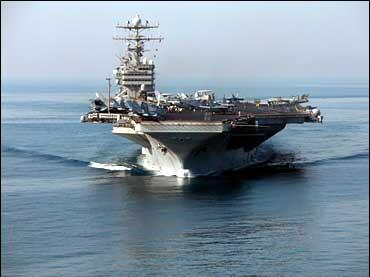Physical Address
304 North Cardinal St.
Dorchester Center, MA 02124
Physical Address
304 North Cardinal St.
Dorchester Center, MA 02124

On Wednesday, the USS Abraham Lincoln, a second Navy aircraft carrier, arrived in the Middle East, accompanied by guided missile destroyers, as confirmed by U.S. Central Command.
This deployment of the Lincoln, which is outfitted with advanced F-35 fighter jets, bolsters the existing naval presence in the region, particularly the USS Theodore Roosevelt aircraft carrier that had reached the area back in mid-July. The movement comes after Defense Secretary Lloyd Austin ordered the Lincoln to redirect from the Indo-Pacific to the Middle East amid growing tensions and expected Iranian aggression towards Israel.
Alongside the Lincoln, Secretary Austin has also dispatched the USS Georgia, a guided missile submarine, marking a rare occasion when the Pentagon has disclosed the location of a submarine within the U.S. Central Command area. Previously, the Pentagon acknowledged a submarine’s presence in November 2023, shortly after the outbreak of conflict in Gaza following Hamas’ attack.
The incoming USS Georgia will join the Lincoln and additional naval forces already stationed in the region. As of Wednesday morning, this includes eight destroyers, not counting those that are escorting the Lincoln.
These strategic orders were issued shortly after both Hezbollah in Lebanon and Iran threatened retaliation against Israel due to a series of targeted killings that occurred at the end of July. Israel has taken responsibility for the airstrike that resulted in the death of Hezbollah commander Fuad Shukr in a Beirut suburb. However, it has not confirmed any involvement in an alleged strike against Hamas leader Ismail Haniyeh in Tehran.
In a previously similar scenario when Iran responded to an Israeli strike on an Iranian consulate in April, Navy destroyers, including the USS Carney, played a crucial role by intercepting and neutralizing a portion of the attack, which consisted of over 300 missiles and drones. This intervention helped limit the damage from the assault, which, despite its scale, resulted in minor impact owing to the defensive actions taken by Israel, the United States, and allied forces.
Currently, U.S. officials have indicated that discussions aimed at reaching a ceasefire to end the ongoing war in Gaza have temporarily postponed Iran’s retaliatory actions. They are currently assessing their response options concerning future developments.
The Pentagon has underscored the importance of sending extra forces to support Israel in the event of an attack while also being prepared for any potential escalation in the situation. Pentagon Press Secretary Maj. Gen. Patrick Ryder stated that the movements are aimed at ensuring “we have the forces in theater to respond to something if it happens now, but also ensuring we have forces in theater to be able to respond to whatever could be next in terms of potential escalation and trying to de-escalate the situation.”
The current dynamic highlights the heightened state of readiness and the strategic maneuvering of U.S. forces in response to escalating tensions in the region, particularly concerning the threats posed by Iran and its allies.
Source: CBS News



